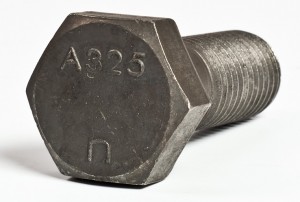 While these two bolts are virtually identical in terms of chemical and physical strengths and properties, there are several differences between the two. The Grade 5 specification falls under the Society of Automotive Engineers (SAE) classification system, while A325 is an ASTM specification. ASTM A325 bolts are more commonly specified by engineers for use in structural steel connections on heavy construction projects, while SAE Grade 5 bolts are more common in OEM-type applications.
While these two bolts are virtually identical in terms of chemical and physical strengths and properties, there are several differences between the two. The Grade 5 specification falls under the Society of Automotive Engineers (SAE) classification system, while A325 is an ASTM specification. ASTM A325 bolts are more commonly specified by engineers for use in structural steel connections on heavy construction projects, while SAE Grade 5 bolts are more common in OEM-type applications.
Grade 5 bolts are most typically made, and are most readily available in a finished hex bolt configuration. A325 bolts are required to have a heavy hex head. The same thing applies for the compatible nuts. Grade 5 nuts are a finished hex pattern, and A194-2H or A563-DH heavy hex nuts are required for use with A325 bolts.
Another difference is that Grade 5 bolts may be specified from 1/4″ diameter up to and including 1-1/2″ diameter. The A325 specification covers bolts from 1/2″ up to and including 1-1/2″ diameter. For bolts larger than 1-1/2″, ASTM A449 should be specified.
Lastly, the required thread lengths are different. Grade 5 fasteners, like most grades, have a standard thread length of twice the diameter plus 1/4″ for bolt lengths less than or equal to 6″ and twice the diameter plus 1/2″ for bolt lengths 6″ and longer. A325 bolts have specific thread lengths, based on the diameter of the bolt, that are shorter than most other bolt grades.
When using a SAE J429 Grade 5, Zinc Plated, with the appropriate Zinc Plated nut in 1/2″ X 13 size, to joint two cold rolled steel plates, what is the preferred locking washer the Flat or the DTI.
It is my understanding that a traditional split lock washer is not recommended for a Grade 5 application.
Thanks,
TomC
@Tom- Neither the flat nor the DTI is a locking washer. To my knowledge there is no prohibition against using a normal split lock washer with grade 5 bolts. If you would prefer not to use split lock washer, there are alternatives such as toothed lock washers or liquid locking compounds.
HI
Can you please tell me the detail specification:
1: High tensile (DIN Grade 8.8. ASTM A325 and
ASTM A 193 B7).
2: Can we guess bolt and nuts are these grades by our eyes (i mean without any test)
@Saftain- The minimum tensile strengths for these grades are all very similar. 8.8 and A325 have a minimum tensile of 830MPa (120ksi), and A193 B7 has a minimum tensile of 860MPa (125ksi). We have detailed summaries on our website for the two ASTM grades, we do not for the 8.8 grade.
All three of those specifications require a grade marking, so yes, you should be able to discern the grade simply by looking.
Are Grade 5 bolts produced from pre-heat treated alloy steel, or are the bolts produced from annealed material for the ease of machining with a subsequent heat treat process?
@Ken- Typically, headed grade 5 bolts are produced from annealed wire or round bar, then headed and heat treated after. Studs can be made either way.
2013 CBC and ASCE 7-10 require Special Inspection for the installation of ASTM A325 and other High Strength Bolts such as ASTM A490. What about Grade 5 bolts? Thanks for any input offered.
@James – Apologies, but we are not familiar with any CBC or ASCE requirements.
Can you impact a split washer on a grade 5 bolt!
@Jasper- We are unsure of what exactly you are asking. Are you referring to a charpy impact test, or an impact wrench? We are happy to help if we can get some clarification.
If I have a Hole Thread With Grade 5 Bolt , another bolt with Grade A325 can be installed
in the same Hole Thread OR Not
Note : Both Bolts ( Bolt Grade 5 & Bolt Grade A325 have the same dimension ) .
Please , answer my question .
Thanks & Regards .
@Mohamed- The A325 should fit and thread into the hole for the grade 5, but whether or not the substitution should be allowed is really a question for the project engineer.